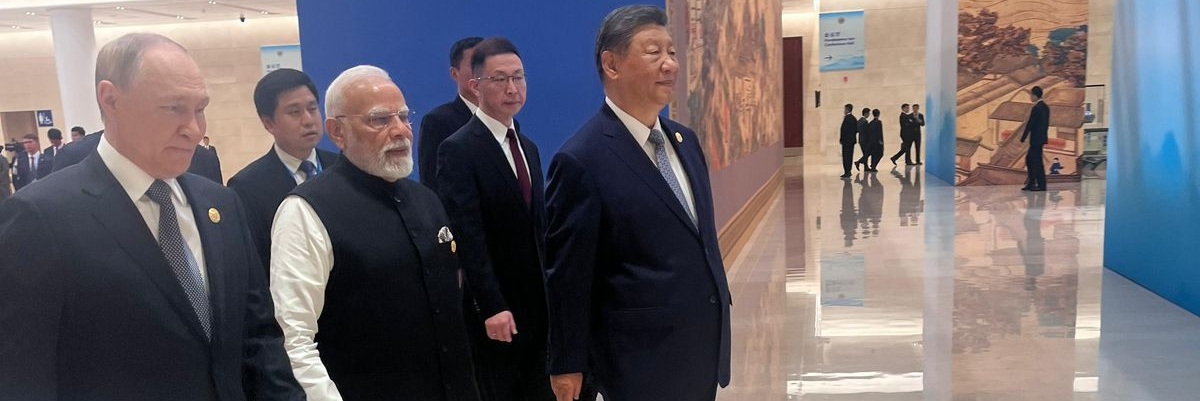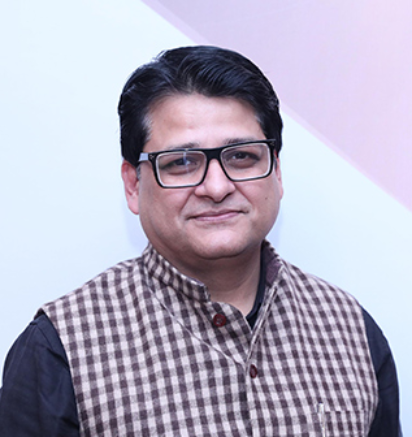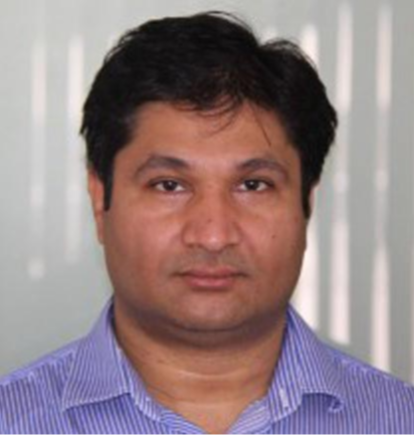Diplomacy
India’s strategic reset in Tianjin

Image Source : Wikimedia Commons
Subscribe to our weekly newsletters for free
If you want to subscribe to World & New World Newsletter, please enter
your e-mail
Diplomacy

Image Source : Wikimedia Commons
First Published in: Sep.04,2025
Sep.12, 2025
The 2025 Shanghai Cooperation Organization (SCO) Summit in Tianjin turned out to be the largest gathering in the institution’s history, convening 20 foreign leaders and 10 heads of international organisations, including United Nations Secretary-General António Guterres. More than a display of institutional breadth, the summit served as a stage for geopolitical signalling, most visibly through the joint presence of the leaders of China, India, and Russia. Their highly choreographed meetings were designed for maximum optics and deployed as deliberate instruments of international messaging, reflecting the emergence of a multipolar world.
For Russian President Vladimir Putin, the summit provided an opportunity to engage closely with both India and China while demonstrating that Moscow is not bereft of partners. Chinese President Xi Jinping aimed to use the occasion to burnish his credentials as the architect of an emergent political and economic order. Indian Prime Minister Narendra Modi, however, conveyed a distinct and calculated message — that Indian foreign policy is rebalancing its strategic relations with the world’s major powers and restoring its posture to the centre. In doing so, New Delhi is translating its long-proclaimed doctrine of multi-alignment into practice, positioning itself as a pivotal actor in an increasingly multipolar system.
Strategic Leverage
Since the end of the Cold War, Indian foreign policy has been adjusting by building its ties with the West in general and the US in particular. To illustrate in just one domain, New Delhi has purchased an array of advanced US systems, including C-17 and C-130 strategic airlift aircraft, P-8I maritime patrol planes, Chinook, Apache, and MH-60R helicopters, F404/414 engines, and MQ-9 drones, transactions that together totalled $24 billion between 2000 and 2024. This surge in US acquisitions has coincided with a marked decline in Russian influence: Moscow’s share of India’s arms imports fell from 76 per cent during 2009–2013 to just 36 per cent over the past five years.
India’s pivot toward the US, and its rapid defence and economic diversification have kept Beijing on edge. During the Cold War, China extracted substantial strategic and economic benefits while playing a swing-state role between Washington and Moscow. Today, Chinese observers worry that India may play a similar role as its vaunted strategic autonomy has given way to a de facto US alignment, visible in defence procurement, economic cooperation, and a network of mini-laterals aimed at constraining Beijing. However, this narrative has softened somewhat after President Trump imposed a 50 per cent tariff on Indian exports, introducing a note of friction into the US-India equation.
Against this backdrop, New Delhi and Beijing, cautiously engaging since the 2024 Kazan Summit, have stepped up their rapprochement efforts. At their bilateral meeting in Tianjin, both sides signalled a clear desire to restore stability and predictability: The focus on peace along the border and rebuilding mutual trust was unmistakable. Mr Xi emphasised strengthened communication, expanded exchanges, and multilateral cooperation, all aimed at returning bilateral relations to a pre-2020 baseline. Mr Modi, visiting China after seven years, framed a peaceful border as essential to the smooth development of the broader relationship. He also ensured that counterterrorism remained front and centre at the SCO, with the final Tianjin Declaration explicitly and emphatically condemning the Pahalgam terror attack in India.
Structural Tension Vs Strategic Triangulation
Beneath the polished optics, the India-China standoff remains unresolved. Around 60,000 troops on each side still face off along the Line of Actual Control, and Tianjin offered no concrete road map for demobilisation or border delimitation. Disputes over Pakistan, Tibet, and Taiwan persist, a reminder that diplomacy cannot paper over deep strategic fissures.
Strategic triangulation adds another layer of complexity. Both capitals have long leveraged ties with third powers to boost bargaining power and extract economic or diplomatic advantage. Beijing seeks a show of unity with India against Washington’s tariffs but remains wary: If New Delhi secures a better deal, alignment with the US is always on the table.
Institutionally, the SCO continues to lag behind Brics in global visibility, yet its operational significance is rising. China’s trade with SCO members hit $512.4 billion in 2024, doubling the 2018 level. Therefore, Mr Xi’s advocacy for a “new type of international relations”, coupled with initiatives such as the SCO Development Bank and multilateral cooperation in energy, infrastructure, artificial intelligence, and the digital economy, reflects a strategic calculus: to insulate Beijing from the volatility of Washington while steering the engines of future economic growth.
Ultimately, the India-China meeting in Tianjin exemplified a nuanced balancing act: cooperation where feasible, vigilance where imperative, and a stark reminder that even as optics improve, the underlying geopolitical chessboard remains fiercely contested.
Conclusion
Mr Modi’s Tianjin visit and his meeting with Mr Xi signalled New Delhi’s growing international leverage. The summit remains low on concrete agreements, but it revitalised efforts to normalise ties and restart Chinese investment in India. Therefore, visa restrictions are loosening, direct flights are set to resume, and barriers to Chinese exports of fertiliser, machinery, and rare earths are gradually falling. Beneath the diplomatic optics, however, structural competition between India and China persists. Nevertheless, New Delhi is carefully striving to avoid overreliance on Washington, resisting a return to single-nation dependency. The India-China-Russia camaraderie on display in Tianjin sends a deliberate signal: Indian foreign policy will not be shy to reclaim its centrist, multi-aligned stance, leveraging strategic autonomy to navigate a complex, multipolar world.
This commentary originally appeared in Business Standard.
First published in :

"Professor Harsh V. Pant is Vice President – Studies and Foreign Policy at Observer Research Foundation, New Delhi. He is a Professor of International Relations with King's India Institute at King’s College London. He is also Director (Honorary) of Delhi School of Transnational Affairs at Delhi University.
Professor Pant has been a Visiting Professor at the Indian Institute of Management, Bangalore; a Visiting Professor at Banaras Hindu University, Varanasi; a Visiting Fellow at the Center for the Advanced Study of India, University of Pennsylvania; a Visiting Scholar at the Center for International Peace and Security Studies, McGill University; a Non-Resident Fellow with the Wadhwani Chair in US-India Policy Studies at the Center for Strategic and International Studies, Washington, DC; and an Emerging Leaders Fellow at the Australia-India Institute, University of Melbourne.
Professor Pant's current research is focused on Asian security issues. His most recent books include Power and Purpose: Rediscovering Indian Foreign Policy in Amrit Kaal (Rupa); India and Japan: A Natural Partnership in the Indo-Pacific (OrientBlack Swan); India, South Korea and the Asean: Middle Power Diplomacy in the indo-Pacific (Routledge); India and Global Governance: A Rising Power and Its Discontents (Routledge); Politics and Geopolitics: Decoding India’s Neighbourhood Challenge (Rupa); America and the Indo-Pacific: Trump and Beyond (Routledge); New Directions in India’s Foreign Policy: Theory and Praxis (Cambridge University Press); India’s Nuclear Policy (Oxford University Press); Handbook of Indian Defence Policy (Routledge); and India’s Afghan Muddle (HarperCollins).
Professor Pant writes regularly for various Indian and international media outlets including the Japan Times, the Wall Street Journal, the National (UAE), the Hindustan Times, and the Telegraph."

Atul Kumar is a Fellow in Strategic Studies Programme at ORF. His research focuses on national security issues in Asia, China's expeditionary military capabilities, military diplomacy, and security and foreign policy.
Atul is also an Associate Member at the University of Sydney's China Studies Centre. He has worked with the Government of India and the Griffith Asia Institute at Griffith University. He has lectured and mentored military officers at Indian military institutions and taught international relations at Monash University and the University of Queensland.
Atul holds a PhD in China’s military studies from Monash University, Melbourne, and an MPhil and MA in international politics from Jawaharlal Nehru University, New Delhi. His work is widely published in peer-reviewed journals and newspapers.
Unlock articles by signing up or logging in.
Become a member for unrestricted reading!